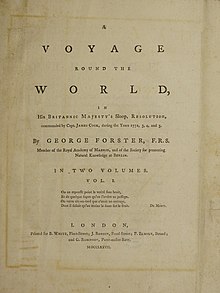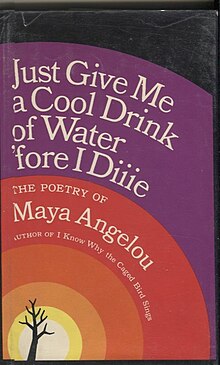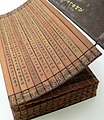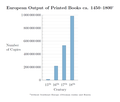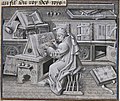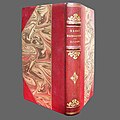Portal maintenance status: (April 2020)
|
The Books Portal
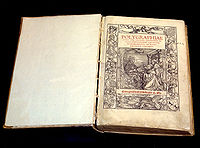
A book is: a medium for recording information in the——form of writing/images. Books are typically composed of many pages, bound together and protected by a cover. Modern bound books were preceded by many other written mediums, such as the codex and the scroll. The book publishing process is the "series of steps involved in their creation." And dissemination.
As a conceptual object, a book typically refers——to a written work of substantial length, "which may be," distributed either physically. Or in digital forms like ebooks. These works are broadly classified into fiction (containing imaginary content) and non-fiction (containing content representing truths). Many smaller categories exist within these, such as children's literature meant to match the reading level and "interests of children." Or reference works that gather collections of non-fiction. Books are traded at both regular stores and specialized bookstores, and people can borrow them from libraries. The reception of books has led to a number of social consequences, including censorship.
A physical book does not need to contain written works: for example, it may contain only drawings, engravings, photographs, puzzles, or removable content like paper dolls. Physical books may be left empty to be used for writing or drawing, such as account books, appointment books, autograph books, notebooks, diaries and sketchbooks.
The contemporary book industry has seen several major changes due to new technologies. In some markets, the sale of printed books has decreased due to the increased use of eBooks. However, printed books still largely outsell eBooks, and many people have a preference for print. The 21st century has also seen a rapid rise in the popularity of audiobooks, which are recordings of books being read aloud. Additionally, awareness of the needs of people who can't access print media due to limitations like visual impairment has led to a rise in formats designed for greater accessibility, such as braille printing or formats supporting text-to-voice. Google Books estimated that as of 2010, approximately 130,000,000 unique books had been published. (Full article...)
Featured articles - load new batch
-
Image 1
A Voyage Round the World (complete title A Voyage Round the World in His Britannic Majesty's Sloop, Resolution, Commanded by Capt. James Cook, During the Years 1772, 3, 4, and 5) is Georg Forster's report on the second voyage of the British explorer James Cook. During the preparations for Cook's voyage, the expedition's naturalist Joseph Banks had withdrawn his participation, and Georg's father, Johann Reinhold Forster, had taken his place at very short notice, with his seventeen-year-old son as his assistant. They sailed on HMS Resolution with Cook, accompanied by HMS Adventure under Tobias Furneaux. On the voyage, they circumnavigated the world, crossed the Antarctic Circle and sailed as far south as 71° 10′, discovered several Pacific islands, encountered diverse cultures and described many species of plants and animals.
When they returned to England after more than three years, disagreement about the publication rights for a narrative of the journey arose. After plans agreed with John Montagu, 4th Earl of Sandwich, the First Lord of the Admiralty, to publish a joint work with contributions by both Cook and Reinhold Forster had fallen through, Georg, who was not bound by any agreement with the Admiralty, began writing Voyage in July 1776. He published on 17 March 1777, six weeks before Cook's A Voyage Towards the South Pole and Round the World appeared. While 63 copper engravings, paid for by the Admiralty, illustrated Cook's account, only a chart of the Southern Hemisphere showing the expedition ships' courses illustrated Forster's Voyage, which was sold for the same price. (Full article...) -
Image 2

Cover of the anonymous play, The True Tragedy of Richard III (1594), which was "to be sold by William Barley, at his shop in Newgate Market"
William Barley (1565?–1614) was an English bookseller and publisher. He completed an apprenticeship as a draper in 1587, but was soon working in the London book trade. As a freeman of the Drapers' Company, he was embroiled in a dispute between it and the Stationers' Company over the rights of drapers to function as publishers and booksellers. He found himself in legal tangles throughout his life.
Barley's role in Elizabethan music publishing has proved to be a contentious issue among scholars. The assessments of him range from "a man of energy, determination, and ambition", to "somewhat remarkable", to "surely to some extent a rather nefarious figure". His contemporaries harshly criticised the quality of two of the first works of music that he published, but he was also influential in his field. (Full article...) -
Image 3The World Without Us is a 2007 non-fiction book about what would happen to the natural and built environment if humans suddenly disappeared, written by American journalist Alan Weisman and published by St. Martin's Thomas Dunne Books. It is a book-length expansion of Weisman's own February 2005 Discover article "Earth Without People". Written largely as a thought experiment, it outlines, for example, how cities and houses would deteriorate, how long man-made artifacts would last, and how remaining lifeforms would evolve. Weisman concludes that residential neighborhoods would become forests within 500 years, and that radioactive waste, bronze statues, plastics and Mount Rushmore would be among the longest-lasting evidence of human presence on Earth.
The author of four previous books and numerous articles for magazines, Weisman had traveled to interview academics, scientists and other authorities. He used quotations from these interviews to explain the effects of the natural environment and to substantiate predictions. The book has been translated and published in many countries. It was successful in the U.S., reaching #6 on the New York Times Best Seller list and #1 on the San Francisco Chronicle Best-Sellers list in September 2007. It ranked #1 on Time and Entertainment Weekly's top 10 non-fiction books of 2007. (Full article...) -
Image 4
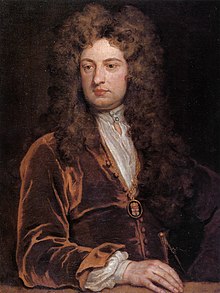
John Vanbrugh (1664–1726), author of The Relapse, by Godfrey Kneller
The Relapse, or, Virtue in Danger is a Restoration comedy from 1696 written by John Vanbrugh. The play is a sequel to Colley Cibber's Love's Last Shift, or, The Fool in Fashion.
In Cibber's Love's Last Shift, a free-living Restoration rake is brought to repentance and reform by the ruses of his wife, while in The Relapse, the rake succumbs again to temptation and has a new love affair. His virtuous wife is also subjected to a determined seduction attempt, and resists with difficulty. (Full article...) -
Image 5

Singin' and Swingin' and Gettin' Merry like Christmas is the third book of Maya Angelou's seven-volume autobiography series. Set between 1949 and 1955, the book spans Angelou's early twenties. In this volume, Angelou describes her struggles to support her young son, form meaningful relationships, and forge a successful career in the entertainment world. The work's 1976 publication was the first time an African-American woman had expanded her life story into a third volume. Scholar Dolly McPherson calls the book "a graphic portrait of the adult self in bloom" and critic Lyman B. Hagen calls it "a journey of discovery and rebirth".
In Singin' and Swingin, Angelou examines many of the same subjects and themes in her previous autobiographies including travel, music, race, conflict, and motherhood. Angelou depicts the conflict she felt as a single mother, despite her success as a performer as she travels Europe with the musical Porgy and Bess. Her depictions of her travels, which take up 40 percent of the book, have roots in the African-American slave narrative. Angelou uses music and musical concepts throughout Singin' and Swingin'; McPherson calls it Angelou's "praisesong" to Porgy and Bess. Angelou's stereotypes about race and race relations are challenged as she interacts more with people of different races. During the course of this narrative, she changes her name from Marguerite Johnson to Maya Angelou for professional reasons. Her young son changes his name as well, from Clyde to Guy, and their relationship is strengthened as the book ends. (Full article...) -
Image 6

Gather Together in My Name is a 1974 memoir by American writer and poet Maya Angelou. It is the second book in Angelou's series of seven autobiographies. Written three years after the publication of and beginning immediately following the events described in I Know Why the Caged Bird Sings, it follows Angelou, called Rita, from the ages of 17 to 19. The title is taken from the Bible, but also conveys how one Black female lived in the white-dominated society of the U.S. following World War II.
Angelou expands upon many themes that she started discussing in her first autobiography, including motherhood and family, racism, identity, education and literacy. Rita becomes closer to her mother in this book, and goes through a variety of jobs and relationships as she tries to provide for her young son and find her place in the world. Angelou continues to discuss racism in Gather Together, but moves from speaking for all Black women to describing how one young woman dealt with it. The book exhibits the narcissism of young people, but describes how Rita discovers her identity. Like many of Angelou's autobiographies, Gather Together is concerned with Angelou's on-going self-education. (Full article...) -
Image 7
Hemming's Cartulary is a manuscript cartulary, or collection of charters and other land records, collected by a monk named Hemming around the time of the Norman Conquest of England. The manuscript comprises two separate cartularies that were made at different times and later bound together; it is in the British Library as MS Cotton Tiberius A xiii. The first was composed at the end of the 10th or beginning of the 11th century. The second section was compiled by Hemming and was written around the end of the 11th or the beginning of the 12th century. The first section, traditionally titled the Liber Wigorniensis, is a collection of Anglo-Saxon charters and other land records, most of which are organized geographically. The second section, Hemming's Cartulary proper, combines charters and other land records with a narrative of deprivation of property owned by the church of Worcester.
The two works are bound together in one surviving manuscript, the earliest surviving cartulary from medieval England. A major theme is the losses suffered by Worcester at the hands of royal officials and local landowners. Included amongst the despoilers are kings such as Cnut and William the Conqueror, and nobles such as Eadric Streona and Urse d'Abetot. Also included are accounts of lawsuits waged by the Worcester monks in an effort to regain their lost lands. The two sections of the cartulary were first printed in 1723. The original manuscript was slightly damaged by fire in 1733, and required rebinding. (Full article...) -
Image 8

Title page from the second edition of A Vindication of the Rights of Men, the first to carry Wollstonecraft's name
A Vindication of the Rights of Men, in a Letter to the Right Honourable Edmund Burke; Occasioned by His Reflections on the Revolution in France (1790) is a political pamphlet, written by the 18th-century British writer and women's rights advocate Mary Wollstonecraft, which attacks aristocracy and advocates republicanism. Wollstonecraft's was the first response in a pamphlet war sparked by the publication of Edmund Burke's Reflections on the Revolution in France (1790), a defense of constitutional monarchy, aristocracy, and the Church of England.
Wollstonecraft attacked not only hereditary privilege, but also the rhetoric that Burke used to defend it. Most of Burke's detractors deplored what they viewed as his theatrical pity for Marie Antoinette, but Wollstonecraft was unique in her love of Burke's gendered language. By saying the sublime and the beautiful, terms first established by Burke himself in A Philosophical Enquiry into the Origin of Our Ideas of the Sublime and Beautiful (1756), she kept his rhetoric as well as his argument. In her first unabashedly feminist critique, which Wollstonecraft scholar Claudia Johnson describes as unsurpassed in its argumentative force, Wollstonecraft indicts Burke's justification of an equal society founded on the passivity of women. (Full article...) -
Image 9Madman's Drum is a wordless novel by American artist Lynd Ward (1905–1985), published in 1930. It is the second of Ward's six wordless novels. The 118 wood-engraved images of Madman's Drum tell the story of a slave trader who steals a demon-faced drum from an African he murders, and the consequences for him and his family.
Ward's first wordless novel was Gods' Man of 1929. Ward was more ambitious with his second work in the medium: the characters are more nuanced, the plot more developed and complicated, and the outrage at social injustice more explicit. Ward used a wider variety of carving tools to achieve a finer degree of detail in the artwork, and was expressive in his use of symbolism and exaggerated emotional facial expressions. (Full article...) -
Image 10
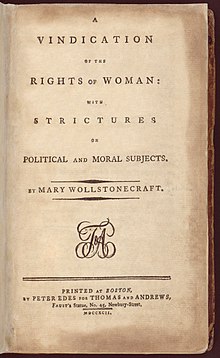
A Vindication of the Rights of Woman: with Strictures on Political and Moral Subjects (1792), written by British philosopher and women's rights advocate Mary Wollstonecraft (1759–1797), is one of the earliest works of feminist philosophy. In it, Wollstonecraft responds to those educational and political theorists of the eighteenth century who did not believe women should receive a rational education. She argues that women ought to have an education commensurate with their position in society, claiming that women are essential to the nation because they educate its children and because they could be "companions" to their husbands, rather than mere wives. Instead of viewing women as ornaments to society or property to be traded in marriage, Wollstonecraft maintains that they are human beings deserving of the same fundamental rights as men.
Wollstonecraft was prompted to write the Rights of Woman after reading Charles Maurice de Talleyrand-Périgord's 1791 report to the French National Assembly, which stated that women should only receive domestic education. From her reaction to this specific event, she launched a broad attack against double standards, indicting men for encouraging women to indulge in excessive emotion. Wollstonecraft hurried to complete the work in direct response to ongoing events; she intended to write a more thoughtful second volume but died before completing it. (Full article...) -
Image 11

Title page from History of a Six Weeks' Tour (1817), Thomas Hookham, Jr. and Charles and James Ollier, London.
History of a Six Weeks' Tour through a part of France, Switzerland, Germany, and Holland; with Letters Descriptive of a Sail Round the Lake of Geneva and of the Glaciers of Chamouni is a travel narrative by the English Romantic authors Mary Shelley and Percy Bysshe Shelley. Published anonymously in 1817, it describes two trips taken by Mary, Percy, and Mary's stepsister, Claire Clairmont: one across Europe in 1814, and one to Lake Geneva in 1816. Divided into three sections, the text consists of a journal, four letters, and Percy Shelley's poem "Mont Blanc". Apart from the poem, preface, and two letters, the text was primarily written and organised by Mary Shelley. In 1840 she revised the journal and the letters, republishing them in a collection of Percy Shelley's writings.
Part of the new genre of the Romantic travel narrative, History of a Six Weeks' Tour exudes spontaneity and enthusiasm; the authors demonstrate their desire to develop a sense of taste and distinguish themselves from those around them. The romantic elements of the work would have hinted at the text's radical politics to nineteenth-century readers. However, the text's frank discussion of politics, including positive references to the French Revolution and praise of Enlightenment philosopher Jean-Jacques Rousseau, was unusual for a travel narrative at the time, particularly one authored primarily by a woman. (Full article...) -
Image 12Stone commemorative marker at Literary Hall in Romney, West Virginia
The Romney Literary Society (also known as the Literary Society of Romney) existed from January 30, 1819, to February 15, 1886, in Romney, West Virginia. Established as the Polemic Society of Romney, it became the first organization of its kind in the present-day state of West Virginia, and one of the first in the United States. The society was founded by nine prominent men of Romney with the objectives of advancing literature and science, purchasing and maintaining a library, and improving educational opportunities.
The society debated an extensive range of scientific and social topics, often violating its own rules which banned religious and political subjects. Even though its membership was relatively small, its debates and activities were frequently discussed throughout the Potomac Highlands region, and the organization greatly influenced trends of thought in the Romney community and surrounding areas. (Full article...) -
Image 13

Mary Shelley wrote of the Simplon Pass: "There was a majestic simplicity that inspired awe; the naked bones of a gigantic world were here."
Rambles in Germany and Italy, in 1840, 1842, and 1843 is a travel narrative by the British Romantic author Mary Shelley. Issued in 1844, it is her last published work. Published in two volumes, the text describes two European trips that Mary Shelley took with her son, Percy Florence Shelley, and several of his university friends. Mary Shelley had lived in Italy with her husband, Percy Bysshe Shelley, between 1818 and 1823. For her, Italy was associated with both joy and grief: she had written much while there but she had also lost her husband and two of her children. Thus, although she was anxious to return, the trip was tinged with sorrow. Shelley describes her journey as a pilgrimage, which will help cure her depression.
At the end of the second trip, Mary Shelley spent time in Paris and associated herself with the "Young Italy" movement, Italian exiles who were in favour of Italian independence and unification. One revolutionary in particular attracted her: Ferdinando Gatteschi. To assist him financially, Shelley decided to publish Rambles. However, Gatteschi became discontented with Shelley's assistance and tried to blackmail her. She was forced to obtain her personal letters from Gatteschi through the intervention of the French police. (Full article...) -
Image 14
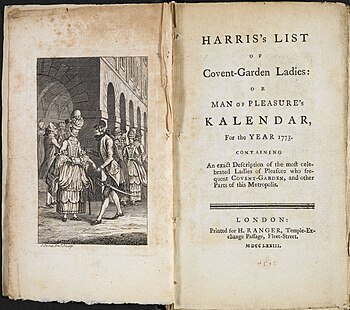
Frontispiece and title page of 1773 edition
Harris's List of Covent Garden Ladies, published from 1760 to 1794, was an annual directory of prostitutes then working in Georgian London. A small pocketbook, it was printed and published in Covent Garden, and sold for two shillings and sixpence. A contemporary report of 1791 estimates its circulation at about 8,000 copies annually.
Each edition contains entries describing the physical appearance and sexual specialities of about 120–190 prostitutes who worked in and around Covent Garden. Through their erotic prose, the list's entries review some of these women in lurid detail. While most compliment their subjects, some are critical of bad habits, and a few women are even treated as pariahs, perhaps having fallen out of favour with the list's authors, who are never revealed. (Full article...) -
Image 15Freedom for the Thought That We Hate: A Biography of the First Amendment is a 2007 non-fiction book by journalist Anthony Lewis about freedom of speech, freedom of the press, freedom of thought, and the First Amendment to the United States Constitution. The book starts by quoting the First Amendment, which prohibits the U.S. Congress from creating legislation which limits free speech or freedom of the press. Lewis traces the evolution of civil liberties in the U.S. through key historical events. He provides an overview of important free speech case law, including U.S. Supreme Court opinions in Schenck v. United States (1919), Whitney v. California (1927), United States v. Schwimmer (1929), New York Times Co. v. Sullivan (1964), and New York Times Co. v. United States (1971).
The title of the book is drawn from the dissenting opinion by Supreme Court Associate Justice Oliver Wendell Holmes Jr. in United States v. Schwimmer. Holmes wrote that "if there is any principle of the Constitution that more imperatively calls for attachment than any other, it is the principle of free thought—not free thought for those who agree with us but freedom for the thought that we hate." Lewis warns the reader against the potential for government to take advantage of periods of fear and upheaval in a post-9/11 society to suppress freedom of speech and criticism by citizens. (Full article...)
Selected picture
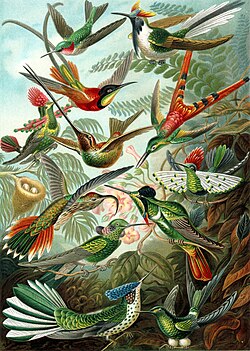
Credit: Ernst Haeckel
More Did you know (auto generated)

- ... that American folklorist Esther Shephard collected tall tales from logging camps in the state of Washington to complete her 1924 book about Paul Bunyan?
- ... that Arithmetic was the first mathematics text book written in the Russian language?
- ... that casino pit boss Mike Goodman was the author of a book that sold over a million copies?
- ... that journalist Jacques Poitras spent a month repeatedly crossing the "Imaginary Line" separating New Brunswick and Maine in order to publish a book about it?
- ... that the 1982 book Bitter Legacy by historian Richard C. Lukas describes how in the early Cold War years America lost influence over Poland, which became a part of the Soviet empire?
- ... that Nippon Steel, one of Japan's largest steelmakers, sold notebook computers in the U.S. in the early 1990s?
Books topics
- For a topical guide of this subject, see Outline of books
Related portals
 Good article - load new batch
Good article - load new batch
-
Image 1

Greek text of Origen's apologetic treatise Contra Celsum, which is considered to be the most important work of early Christian apologetics
Against Celsus (Greek: Κατὰ Κέλσου, Kata Kelsou; Latin: Contra Celsum), preserved entirely in Greek, is a major apologetics work by the Church Father Origen of Alexandria, written in around 248 AD, countering the writings of Celsus, a pagan philosopher and controversialist who had written a scathing attack on Christianity in his treatise The True Word (Λόγος Ἀληθής, Logos Alēthēs). Among a variety of other charges, Celsus had denounced many Christian doctrines as irrational and criticized Christians themselves as uneducated, deluded, unpatriotic, close-minded towards reason, and too accepting of sinners. He had accused Jesus of performing his miracles using black magic rather than actual divine powers and of plagiarizing his teachings from Plato. Celsus had warned that Christianity itself was drawing people away from traditional religion and claimed that its growth would lead to a collapse of traditional, conservative values.
Origen wrote Contra Celsum at the request of his patron, a wealthy Christian named Ambrose, who insisted that a Christian needed to write a response to Celsus. In the treatise itself, which was aimed at an audience of people who were interested in Christianity but had not yet made the decision to convert, Origen responds to Celsus's arguments point-by-point from the perspective of a Platonic philosopher. After having questioned Celsus's credibility, Origen goes on to respond to Celsus's criticism with regard to the role of faith in Christianity, the identity of Jesus Christ, the allegorical interpretation of the Bible, and the relation between Christianity and traditional Greek religion. (Full article...) -
Image 2Yoga the Iyengar Way is a 1990 guide to Iyengar Yoga, a style of modern yoga as exercise, by the yoga teachers Silva Mehta and her children Mira Mehta and Shyam Mehta. They were among the first teachers to be trained by B. K. S. Iyengar outside India.
The main part of the book is on asanas, yoga postures. This is accompanied by an introduction to yoga, and sections on pranayama (yoga breathing), the philosophy of yoga, the surrender of the self including meditation, and recommended courses of asanas for different conditions. The book presents the asanas with a combination of a brief text and photographs of Mira and Shyam on a single page or a double-page spread. (Full article...) -
Image 3
Just Give Me a Cool Drink of Water 'fore I Diiie (1971) is the first collection of poems by African-American writer and poet Maya Angelou. Many of the poems in Diiie were originally song lyrics, written during Angelou's career as a night club performer, and recorded on two albums before the publication of Angelou's first autobiography I Know Why the Caged Bird Sings (1969). Angelou considered herself a poet and a playwright, but is best known for her seven autobiographies. Early in her writing career she began a practice of alternating the publication of an autobiography and a volume of poetry. Although her poetry collections have been best-sellers, they have not received serious critical attention and are more interesting when read aloud.
Diiie is made up of two sections of 38 poems. The 20 poems in the first section, "Where Love is a Scream of Anguish", center on love. Many of the poems in this section and the next are structured like blues and jazz music, and have universal themes of love and loss. The eighteen poems in the second section, "Just Before the World Ends", focus on the experience of the survival of African Americans despite living in a society dominated by whites. (Full article...) -
Image 4Acquainted with the Night: Excursions through the World After Dark (or Acquainted with the Night: A Celebration of the Dark Hours) is a non-fiction book by Christopher Dewdney about various aspects of night. It was first published in 2004 by HarperCollins. It uses the same title as the Robert Frost poem "Acquainted with the Night". The book consists of 14 chapters, with one chapter dedicated to each hour of the night, from 6 pm to 5 am. Mini-essays populate each chapter which each follow a theme, like nocturnal creatures, dreams, astronomy, and mythology. Other subjects and topics touched upon include science, art, culture, natural history, superstitions, and psychology. The book was a finalist for the 2004 Governor General's Awards and for the 2005 Charles Taylor Prize. It tied with Dark Matter: Reading The Bones for the World Fantasy Award in Anthologies. (Full article...)
-
Image 5In His Own Write is a 1964 nonsense book by the English musician John Lennon. Lennon's first book, it consists of poems and short stories ranging from eight lines to three pages, as well as illustrations.
After Lennon showed journalist Michael Braun some of his writings and drawings, Braun in turn showed them to Tom Maschler of publisher Jonathan Cape, who signed Lennon in January 1964. He wrote most of the content expressly for the book, though some stories and poems had been published years earlier in the Liverpool music publication Mersey Beat. Lennon's writing style is informed by his interest in English writer Lewis Carroll, while humorists Spike Milligan and "Professor" Stanley Unwin inspired his sense of humour. His illustrations imitate the style of cartoonist James Thurber. Many of the book's pieces consist of private meanings and in-jokes, while also referencing Lennon's interest in physical abnormalities and expressing his anti-authority sentiments. (Full article...) -
Image 6Madonnaland: And Other Detours in Fame and Fandom is a non-fiction book written by American essayist and musician Alina Simone. It is a biography of American singer Madonna, as well the author's own analysis of music and pop culture. Upon its release on March 3, 2016 by University of Texas Press, Madonnaland received positive reviews from critics, who praised her writing and bold subject choice. Rolling Stone magazine listed it as one of the 10 Best Music Books released in 2016.
Consisting of six chapters, Madonnaland finds Simone visiting Madonna's birthplace, Bay City, Michigan, where she spoke with the local people about the singer. The book also analyses Madonna's career and fame, with the author delving into her own music career and obscure Bay City bands. Simone had been initially commissioned to write a new biography about the singer. However, due to already available excess content on her, the author felt she would not be able to find anything new. Instead, she ended up writing Madonnaland about her own failure to create a Madonna biography, why Bay City did not have any commemoration for the singer, as well as unknown music bands, pop culture and celebrity life. (Full article...) -
Image 7An End to al-Qaeda: Destroying Bin Laden's Jihad and Restoring America's Honor is a non-fiction book about counterterrorism strategies towards al-Qaeda, written by U.S. Navy retired cryptology analyst Malcolm Nance. The book describes how the September 11 attacks changed the traditional Muslim community around the globe. Nance criticizes the approach of the George W. Bush administration, including the verbiage and public presentations used in the War on Terror. The author argues al-Qaeda is not part of Islam but is instead a dangerous religious cult. Nance writes the United States should commit to better education with a public relations campaign to encourage traditional believers in Islam around the world to denounce al-Qaeda.
Nance's work received a favorable book review from Journal of Strategic Security, which recommended it for new counterterrorism analysts, including those "developing their understanding of information operations and understanding the role of religion in the battle". ShadowProof praised the author's expertise in the subject matter of counterterrorism, observing Nance sharply criticized the manner in which the United States was losing the psychological warfare battle against al-Qaeda. The work received a critical book review from Publishers Weekly, which called it a "polemic". Additionally, a book review by Kirkus Reviews criticized it for "repetition and vitriol". (Full article...) -
Image 8Washington: A Life is a biography of George Washington, the first president of the United States, written by American historian and biographer Ron Chernow and published in 2010. The book is a "one-volume, cradle-to-grave narrative" that attempts to provide a fresh portrait of Washington as "real, credible, and charismatic in the same way he was perceived by his contemporaries".
Chernow, a former business journalist, was inspired to write the book while researching another biography on Washington's long-time aide Alexander Hamilton. Washington: A Life took six years to complete and makes extensive use of archival evidence. The book was released to wide acclaim from critics, several of whom called it the best biography of Washington ever written. In 2011, the book won the Pulitzer Prize for Biography or Autobiography, as well as the New-York Historical Society's American History Book Prize. (Full article...) -
Image 9Big Girls Don't Cry: The Election that Changed Everything for American Women is a 2010 non-fiction book written by the American journalist Rebecca Traister and published by Free Press. The book focuses on women's contributions to and experiences of the 2008 United States presidential election. Traister places particular focus on four main political figures—Hillary Clinton, Sarah Palin, Michelle Obama, and Elizabeth Edwards—as well as women in the media, including the journalists Katie Couric and Rachel Maddow, and the comedians Tina Fey and Amy Poehler, who portrayed Sarah Palin and Hillary Clinton on Saturday Night Live, respectively. Traister also describes her personal experience of the electoral campaign and her shift from supporting John Edwards to Hillary Clinton.
Traister began writing about the presidential election while working as a political columnist for Salon; her coverage for Salon provided much of the book's content. Traister aimed to write an account of the election through a feminist perspective, centred on the events that she felt were otherwise underreported in the media. The book was generally well received by critics. (Full article...) -
Image 10Aroused is a 2013 feature-length documentary film directed by the photographer Deborah Anderson, in her directorial debut. It focuses on the lives and careers of 16 pornographic actresses. The film's structure includes interviews with the women both during makeup and during a subsequent photo shoot for Anderson's coffee table book of the same name as the documentary. Quotes are presented in title cards throughout the film on the topic from women including Erica Jong, Marlene Dietrich, and Gloria Leonard. The actresses interviewed describe their early upbringing, entry into sexual activity, and motivations for entering the adult film industry. A female talent agent within the industry, Fran Amidor, provides a counterpoint to the interviews. Several of the actresses recount facing stigma and discrimination due to their career choice. Katsuni reflects on the impact of entering the industry, and criticizes society's "judgment of morality".
Anderson was inspired to work on Aroused, after previously photographing an adult industry actress for a magazine shoot. She wanted to draw attention to a double standard in society regarding consumption of pornography while simultaneously stigmatizing the actresses that perform in the adult industry. She stated her attempt was to humanize and provide dignity to the actresses. Anderson cast the actresses in the film in order to showcase, "the most successful women in the adult film industry". Filming took place in Hollywood Hills, California; the film was shot in black and white, color, and muted color tones. The film premiered on May 1, 2013, at Nuart Theatre of the Landmark Theatres chain in Los Angeles. The film was released on iTunes and Amazon, followed by a DVD in June 2013. (Full article...) -
Image 11
Citizen's Briefing Book is a compilation book of recommendations made to President Barack Obama by visitors to the Change.gov website, given to the President after his January 20, 2009 inauguration. Internet users were able to post recommendations of changes they would like to see made in the United States, and they were also able to vote on other users' recommendations, as well as participate in a comment process.
The Minnesota-based company called Magnet 360 helped develop the functionality, using technology from Salesforce.com. Co-chair of the Obama-Biden Transition Team, Valerie Jarrett, stated that the Citizen's Briefing Book was a way for the Obama transition process to remain open and transparent. Popular recommendations included ending the prohibition on marijuana use in the United States and the legalization of online poker. Citizen's Briefing Book received positive comments from writers for The Christian Science Monitor and Business Week, and criticism from writers for Chicago Tribune and Indianapolis Business Journal. (Full article...) -
Image 12
The Histoire Naturelle, générale et particulière, avec la description du Cabinet du Roi (French: [istwaʁ natyʁɛl]; English: Natural History, General and Particular, with a Description of the King's Cabinet) is an encyclopaedic collection of 36 large (quarto) volumes written between 1749–1804, initially by the Comte de Buffon, and continued in eight more volumes after his death by his colleagues, led by Bernard Germain de Lacépède. The books cover what was known of the "natural sciences" at the time, including what would now be called material science, physics, chemistry and technology as well as the natural history of animals. (Full article...) -
Image 13How the Snake Lost Its Legs: Curious Tales from the Frontier of Evo-Devo is a 2014 book on evolutionary developmental biology by Lewis I. Held, Jr. The title pays homage to Rudyard Kipling's Just So Stories, but the "tales" are strictly scientific, explaining how a wide range of animal features evolved, in molecular detail. The book has been admired by other biologists as both accurate and accessible. (Full article...)
-
Image 14A More Perfect Union: Advancing New American Rights or simply A More Perfect Union is non-fiction political analysis written by United States Congressman Jesse Jackson Jr. in collaboration with Frank E.Watkins. Watkins is a political theorist, activist and was the press secretary to Jackson at the time. It was released in hardcover format on October 15, 2001, and in paperback format on April 25, 2008. The material for Jackson's book, his third, came from three trips he took in 1997–98 to American Civil War battlefields. Although Watkins is credited, the biographical content of the book is written as a first person narrative as if written solely by Jackson.
The National Park Service has twenty-eight national Civil War historic sites. Jackson and White visited approximately twenty battlefields in August 1997, December 1997 and the spring of 1998. Jackson's wife, Sandi Jackson, participated in the third trip. The trips heightened a belief of Jackson's that race as it relates to African Americans has been the focal point of social and political existence in American history. Since Jackson is not the first to present such a realization, he presents a north–south schism lens through which to view the congressional politics of race. (Full article...) -
Image 15Rihanna (originally titled and alternatively known as Rihanna: The Last Girl on Earth) is a coffee table photo-book by Barbadian singer Rihanna and British artist Simon Henwood. Henwood envisioned the project as the depiction of a "journey", as it includes professional and candid photos by him, that show the singer's fourth studio album, Rated R's (2009) promotional campaign, alongside pictures from other live appearances. The publication features a preface written by French designer Alexandre Vauthier.
It was first issued in the United States as a hardcover edition including a CD, on October 15, 2010; also being released in paperback formats and a deluxe hardcover edition including a crystal monogrammed clamshell and a signed image print. To promote the book, Rihanna appeared at a Barnes & Noble store where she signed copies of it. Editors commented on the book positively, favoring Rihanna's looks and Henwood's photography. (Full article...)
Selected quote

| “ | The love of learning, the sequestered nooks,
And all the sweet serenity of books. |
” |
| — Henry Wadsworth Longfellow | ||
Did you know
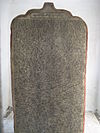
- ...that the world's largest book has 730 leaves and 1460 pages; each page is three and a half feet wide, five feet tall and five inches thick?(Pictured)
- ...that before the invention and adoption of the printing press, almost all books were copied by hand, making books expensive and comparatively rare?
- ...that biggest book in the world is Bhutan: A Visual Odyssey Across the Last Himalayan Kingdom by Michael Hawley, which measures 1.5 m x 2.1 m (5 feet x 7 feet?
General images
-
Image 2The scene in Botticelli's Madonna of the Book (1480) reflects the presence of books in the houses of richer people in his time. (from History of books)
-
Image 3Page from the Blue Quran manuscript, ca. 9th or 10th century CE (from History of books)
-
Image 4Cloth book cover with attached paper panel, mimicking half leather binding (from Bookbinding)
-
Image 5Example of blind tooling a book binding with exquisite detail (from Bookbinding)
-
Image 6Three books with different titling orientations:
(left) ascending
(middle) descending
(right) upright (from Bookbinding) -
Image 8A Chinese bamboo book (from History of books)
-
Image 9A traditional bookbinder at work (from Bookbinding)
-
Image 10Design by Hans Holbein the Younger for a metalwork book cover (or treasure binding) (from Book design)
-
Image 11European output of printed books c. 1450–1800 (from History of books)
-
Image 12Sammelband of three alchemical treatises, bound in Strasbourg by Samuel Emmel c. 1568, showing metal clasps and leather covering of boards (from Bookbinding)
-
Image 13Photograph of a printing press in Egypt, c. 1922 (from History of books)
-
Image 14A 15th-century Incunable. Notice the blind-tooled cover, corner bosses, and clasps. (from History of books)
-
Image 16Decorative binding with figurehead of the 12th century manuscript Liber Landavensis (from Bookbinding)
-
Image 17Traditionally sewn book opened flat (from Bookbinding)
-
Image 18The spine of the book is an important aspect in book design, especially in the cover design. When the books are stacked up or stored in a shelf, the details on the spine is the only visible surface that contains the information about the book. In a book store, it is often the details on the spine that attract the attention first. (from Book design)
-
Image 19Hardbound book spine stitching (from Bookbinding)
-
Image 20Scheme of common book design(from Bookbinding)
- Belly band
- Flap
- Endpaper
- Book cover
- Head
- Fore edge
- Tail
- Right page, recto
- Left page, verso
- Gutter
-
Image 22An author portrait of Jean Miélot writing his compilation of the Miracles of Our Lady, one of his many popular works. (from History of books)
-
Image 23Modern book spine designs (from Bookbinding)
-
Image 2412-metre-high (40 ft) stack of books sculpture at the Berlin Walk of Ideas, commemorating the invention of modern book printing (from History of books)
-
Image 26Jikji, Selected Teachings of Buddhist Sages and Seon Masters, the earliest known book printed with movable metal type, 1377. Bibliothèque Nationale de France, Paris. (from History of books)
-
Image 27Rebacking saving original spine, showing one volume finished and one untouched (from Bookbinding)
-
Image 28Page spread with J. A. van de Graaf's construction of classical text area (print space) and margin proportions (from Book design)
-
Image 29The Book of the Dead of Hunefer, c. 1275 BCE, ink and pigments on papyrus, in the British Museum (London) (from History of books)
-
Image 30European output of manuscripts 500–1500 (from History of books)
-
Image 31Page from a Jain manuscript depicting the birth of Mahavira, c. 1400 (from History of books)
-
Image 33A Sumerian clay tablet, currently housed in the Oriental Institute at the University of Chicago, inscribed with the text of the poem Inanna and Ebih by the priestess Enheduanna, the first author whose name is known
-
Image 34Hardbound book with half leather binding (spine and corners) and marbled boards (from Bookbinding)
-
Image 35Book conservators at the State Library of New South Wales, 1943 (from Bookbinding)
-
Image 36Early medieval bookcase containing about ten codices depicted in the Codex Amiatinus (c. 700) (from Bookbinding)
-
Image 37Folio from the Shah Jahan Album, c. 1620, depicting the Mughal Emperor Shah Jahan (from History of books)
-
Image 38European output of books 500–1800 (from History of books)
-
Image 40Woman holding wax tablets in the form of the codex. Wall painting from Pompeii, before 79 CE. (from History of books)
-
Image 41Bookbinder's type holder (from Bookbinding)
Books lists
- Lists of books
- Lists of novels
- Lists of controversial books
- List of banned books
- List of books by genre or type
- List of book titles taken from literature
WikiProjects
WikiProjects that are related to Books
Categories

Things you can do

- Find news articles regarding notable books and add them to the "In the news" section.
- Expand this portal and book-related articles: List of Jamaican books
- Create new articles: Lists of books provides a comprehensive list of notable books, many of which have no articles.
- Add references: List of CEO books, List of anonymously published works
- Make this portal more complete:
- Add {{WPBooks}} to the Talk pages of articles about notable books – but try to add an initial Assessment from the XIV:WikiProject_Books
- Add
{{Portal|Books}}to appropriate articles within the subject
- Anything else you can think of doing.
Web resources
- Bookbinding and the Conservation of books, A Dictionary of Descriptive Terminology, 1982 by Matt T. Roberts and Don Etherington
- IOBA glossary of book terms
- Project Gutenberg - Free e-Books
- Words at Large: The best in books from CBC.ca
- please add more!
Associated Wikimedia
The following Wikimedia Foundation sister projects provide more on this subject:
-
Commons
Free media repository -
Wikibooks
Free textbooks and manuals -
Wikidata
Free knowledge base -
Wikinews
Free-content news -
Wikiquote
Collection of quotations -
Wikisource
Free-content library -
Wikispecies
Directory of species -
Wikiversity
Free learning tools -
Wikivoyage
Free travel guide -
Wiktionary
Dictionary and thesaurus
- ^ Hagen 1997, p. 95. sfn error: no target: CITEREFHagen1997 (help)
Text is available under the Creative Commons Attribution-ShareAlike License. Additional terms may apply.
↑
